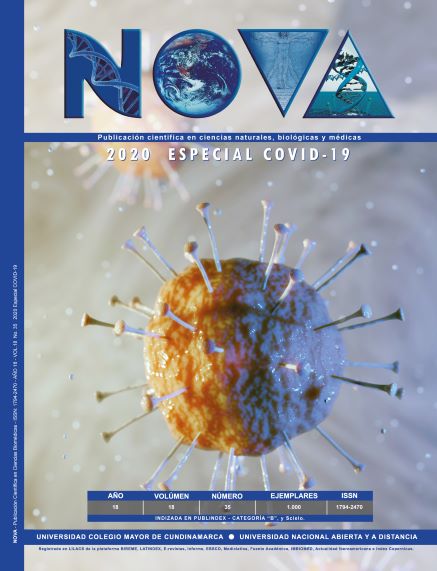NOVA by http://www.unicolmayor.edu.co/publicaciones/index.php/nova is distributed under a license creative commons non comertial-atribution-withoutderive 4.0 international.
Furthermore, the authors keep their property intellectual rights over the articles.
Show authors biography
Severe Acute Respiratory Syndrome (SARS) is the serious condition of coronavirus (COVID-19) caused by SARS-COV-2 which causes respiratory infections in humans, and whose transmission is given mainly through the contact. this virus enters into the host cell due to the spike protein (S) interaction with the angiotensin-converting enzyme 2 (ACE2), which is not only present in the respiratory tract but also monocytes, macrophages, endothelial cells, the heart, and gastrointestinal tract. The increase in INF stops viral replication and activates the adaptive immune response. The infection's clinic manifestations often occur in the respiratory tract; however, other systems like the hematopoietic may be affected. Altered cell counts, mainly leukocytes and platelets, are seen on the blood count. Lymphopenia and neutrophilia are associated with severe disease; thrombocytopenia is present in a heterogeneous way in the infection. Among the disease's complications are the Disseminated Intravascular Coagulation (DIC) that results when monocytes and endothelial cells are activated because of the release of cytokines, causing endothelial damage, with the synthesis of the tissue factor, tissue factor discharge, platelet activation, and the von Willebrand factor release, generating a hyperfibrinolytic condition especially in the infection's late-stage. Laboratory tests such as D-dimer (D-D), Fibrinogen Degradation Products (FDP), Prothrombin Time (PT), Activated Partial Thromboplastin Time (APTT) among others, are essential to the diagnosis, monitoring, and prognosis of the disease.
Article visits 363 | PDF visits 475
Downloads
1. Lozada-Requena I, Ponce CN. COVID-19: respuesta inmune y perspectivas de intervenciones terapéuticas. Rev Peru Med Exp Salud Publica. 2020;37(2):312–9.
2. Wu H. E. Síndrome Respiratorio Agudo Severo. Revista Chilena de Pediatria. 2003.
3. Lin L, Lu L, Cao W, Li T. Hypothesis for potential pathogenesis of SARS-CoV-2 infection–a review of immune changes in patients with viral pneumonia. Emerg Microbes Infect. 2020;9(1):727–32.
4. Terpos E, Ntanasis-Stathopoulos I, Elalamy I, Kastritis E, Sergentanis TN, Politou M, et al. Hematological findings and complications of COVID-19. Am J Hematol. 2020;95(7):834–47.
5. García-Salido A. Narrative review of the immune response against coronavirus: An overview, applicability for SARS-COV-2, and therapeutic implications. An Pediatr [Internet]. 2020;93(1):60.e1-60.e7. DOI: 10.1016/j.anpedi.2020.04.016
6. El E, Nl H-, Severo RA, Oriente M, Oriente M, Cov S-. Revisión breve sobre COVID-19. Osmosis Rev Medica Estud. 2020;1(12):8. Available from: https://wdg.biblio.udg.mx/COVID19/bayro2020editorial.pdf
7. Marietta M, Ageno W, Artoni A, De Candia E, Gresele P, Marchetti M, et al. COVID-19 and haemostasis: A position paper from Italian Society on Thrombosis and Haemostasis (SISET). Blood Transfus. 2020;18(3):167–9.
8. Li G, Fan Y, Lai Y, Han T, Li Z, Zhou P, et al. Coronavirus infections and immune responses. J Med Virol. 2020;92(4):424–32.
9. Walls AC, Park YJ, Tortorici MA, Wall A, McGuire AT, Veesler D. Structure, Function, and Antigenicity of the SARS-CoV-2 Spike Glycoprotein. Cell [Internet]. 2020;181(2):281-292.e6. DOI:10.1016/j.cell.2020.02.058
10. Yang X, Yu Y, Xu J, Shu H, Xia J, Liu H, et al. Clinical course and outcomes of critically ill patients with SARS-CoV-2 pneumonia in Wuhan, China: a single-centered, retrospective, observational study. Lancet Respir Med [Internet]. 2020;8(5):475–81. DOI: 10.1016/S2213-2600(20)30079-5
11. Tan L, Wang Q, Zhang D, Ding J, Huang Q, Tang YQ, et al. Lymphopenia predicts disease severity of COVID-19: a descriptive and predictive study. Signal Transduct Target Ther. 2020;5(1):16–8.
12. Fan BE, Chong VCL, Chan SSW, Lim GH, Lim KGE, Tan GB, et al. Hematologic parameters in patients with COVID-19 infection. Am J Hematol. 2020;95(6):E131–4.
13. Zini G, Bellesi S, Ramundo F, d’Onofrio G. Morphological anomalies of circulating blood cells in COVID-19. Am J Hematol. 2020;95(7):870–2.
14. Salib C, Teruya-Feldstein J. Hypersegmented granulocytes and COVID-19 infection. Blood. 2020;135(24):2196.
15. Guan W, Ni Z, Hu Y, Liang W, Ou C, He J, et al. Clinical characteristics of coronavirus disease 2019 in China. N Engl J Med. 2020;382(18):1708–20.
16. Ranucci M, Ballotta A, Di Dedda U, Bayshnikova E, Dei Poli M, Resta M, et al. The procoagulant pattern of patients with COVID-19 acute respiratory distress syndrome. J Thromb Haemost. 2020;(March):1–5.
17. Weiss SR, Navas-Martin S. Coronavirus Pathogenesis and the Emerging Pathogen Severe Acute Respiratory Syndrome Coronavirus. Microbiol Mol Biol Rev. 2005;69(4):635–64.
18. Ding R, Wang Z, Lin Y, Liu B, Zhang Z, Ma X. Comparison of a new criteria for sepsis-induced coagulopathy and International Society on Thrombosis and Haemostasis disseminated intravascular coagulation score in critically ill patients with sepsis 3.0: A retrospective study. Blood Coagul Fibrinolysis. 2018;29(6):551–8.
19. Connors JM, Levy JH. COVID-19 and its implications for thrombosis and anticoagulation. Blood. 2020;135(23):2033–40.
20. Tang N, Li D, Wang X, Sun Z. Abnormal coagulation parameters are associated with poor prognosis in patients with novel coronavirus pneumonia. J Thromb Haemost. 2020;18(4):844–7.
21. Yin S, Huang M, Li D, Tang N. Difference of coagulation features between severe pneumonia induced by SARS-CoV2 and non-SARS-CoV2. J Thromb Thrombolysis. 2020;3–6. DOI: 10.1007/s11239-020-02105-8
22. Violi F, Pastori D, Cangemi R, Pignatelli P, Loffredo L. Hypercoagulation and Antithrombotic Treatment in Coronavirus 2019: A New Challenge. Thromb Haemost. 2020;120(6):949–56.
23. Yan Zhang, M.D. Meng Xiao, M.Sc. Shulan Zhang, M.D. Peng Xia MD, Wei Cao MD, Wei Jiang MD, Huan Chen MD, Xin Ding MD, Hua Zhao, M.D. Hongmin Zhang MD. Correspondence Coagulopathy and Antiphospholipid Antibodies in Patients with Covid-19. Nejm. 2020;38(1):1–3.
24. Ellinghaus D, Degenhardt F, Bujanda L, Buti M, Albillos A, Invernizzi P, et al. Genomewide Association Study of Severe Covid-19 with Respiratory Failure. N Engl J Med. 2020;NEJMoa2020283. http://www.nejm.org/doi/10.1056/NEJMoa2020283






